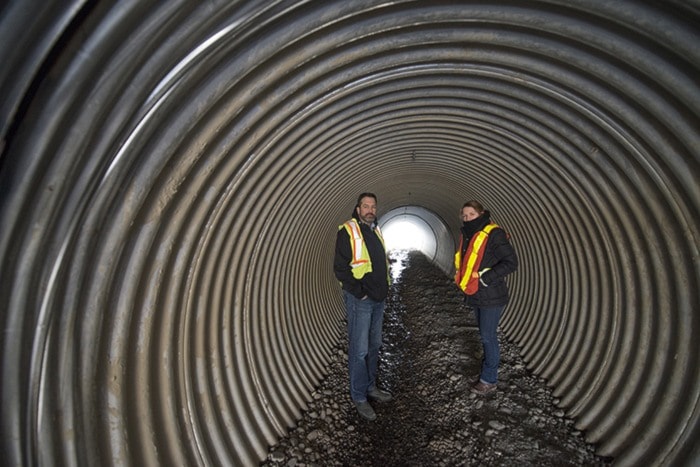[WARNING – The above image gallery contains a few photographs of a graphic nature and should not be viewed by those who might be offended]
The newly opened South Fraser Perimeter Road cuts a direct path through Delta’s pastoral landscapes and alongside pristine peat forest, but the deer living along the corridor aren’t adjusting as well as their lead-footed neighbours.
According to the province’s accident reporting system at least 10 deer have been struck and killed by cars since the highway opened to great fanfare in late December.
Don DeMill, a biologist working as a contractor for the Corporation of Delta in Burns Bog, says the number will likely increase unless drivers slow down.
“I wasn’t happy that the highway was built and I don’t think it should have been built where it was,” says DeMill, who has been working in the bog since 1988.
DeMill recently found and photographed a deer that had been killed and dragged off the road near the culvert at the 92nd Street alignment in Tilbury. Although a three-metre-tall wildlife culvert exists at that crossing, the entrances are flooded with water and DeMill says it would “discourage” deer from entering. Even wearing his hip waders, DeMill was unable to cross the pond barring the entrance.
“This will be a great crossing for beavers only,” he says. “No deer or bear would ever go through it.”
Malcolm Smith, a biologist and environmental advisor for the province, acknowledges the problems with the SFPR’s culverts, but says they’re still a work in progress. There are 25 wildlife crossings along the 37-kilometre highway, and crews are planning on installing signs advising drivers of this fact in the near future.
“For the coming years we’ll be monitoring the activity of these [culverts] and how much they’re used,” says Smith.
Monitoring can come in the form of closed circuit cameras or print tracking to identify the type of mammal most frequently using the crossing.
Along the northwestern portion of Burns Bog where the SFPR runs closest to wildlife, the province has installed several three-metre culverts for deer and other large mammals, as well as one and two-metre culverts for raccoons, coyotes, and smaller creatures.
During the planning phase of the SFPR, Smith says teams were mapping habitat values along the corridor in order to understand what types of animals were in each area and how to anticipate their movement patterns.
“The biggest areas of large mammal movements was actually more adjacent to Crescent Slough because we know that the deer are moving between Burns Bog and the farm fields,” he says.
Lori Leach, an environmental coordinator with the province, says her team created hedgerows along that portion of the highway to maintain those local movements. Sandhill cranes that roost in the bog have returned to farmers’ fields since the highway opened, as have deer and other wildlife.
In some areas the province created or enhanced wildlife habitat along the highway, including wetlands, snags (standing dead trees) for natural bird houses or raptor perches, nesting boxes, and bat boxes.
“It’s not that habitat was lost for bats, it was just to provide habitat,” says Leach.
Although she acknowledges the highway created a divider through natural habitat the goal on the project was to enhance the remaining ecosystems.
“So maybe you have less habitat but you have higher values of ecological diversity,” says Leach.
DeMill recommended the creation of natural wildlife corridors during his time on Delta’s environmental committee prior to the creation of the SFPR. But these corridors would have been linked to the bog via bridges and not water-logged culverts.
“Sure, it would have been expensive, but they could have done it,” he says.
DeMill is also concerned the number of deer hit by cars on the road could be much higher, pointing out many could have been hit and still limped into the bog to die.
